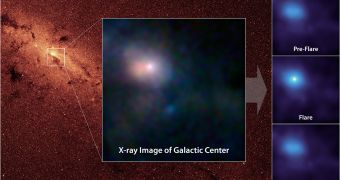NASA's shiny new NuSTAR X-ray space telescope is not wasting any time. It's only been in orbit since June, but it's already churning out interesting results and data.
In fact, it didn't even need four months to do it, barely a month after it was put into orbit, the telescope captured a very rare phenomenon, at least in our galaxy, an X-ray burst from the center of the Milky Way.
The burst, as you may have guessed, comes from the relatively small supermassive black hole at the center of our galaxy. Since we've been aware of its existence, not very long, the black hole has been fairly quiet.
This would indicate that there's not much around it to feed on. But this past July, NuSTAR was pointed at Sagittarius A*, the radio source at the center of our galaxy widely accepted to be a supermassive black hole.
It only looked at it for two days, but it was enough to capture a sudden and short X-ray burst in the region, a hint that our black hole gobbled up something.
Now, obviously, black holes don't emit anything, at least not anything we can detect, or they wouldn't be worthy of their names.
But the gas and material that is unfortunate enough to get too close to one and get sucked in gets very hot in the process. So hot that it emits radiation in the X-ray spectrum, which is exactly what NuSTAR was designed to detect.
What NuSTAR saw was the result of gas being heated to enormous temperatures, 100 million degrees Celsius, 180 million Fahrenheit.
"Astronomers have long speculated that the black hole's snacking should produce copious hard X-rays, but NuSTAR is the first telescope with sufficient sensitivity to actually detect them," NuSTAR team member Chuck Hailey, of Columbia University NY, said.

 14 DAY TRIAL //
14 DAY TRIAL //